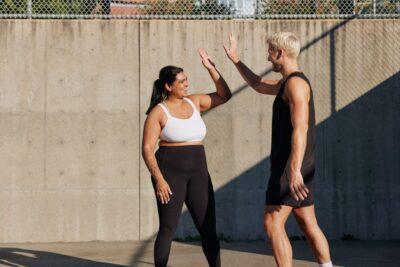The internet has broken down the traditional walls between a distributor and their audience and fitness blogs are an example of this. Previously if a fitness expert wanted to get their ideas out to a wider audience, they would have to write an article in a newspaper or appear on tv or radio. However, opportunities to do this were and still are a rarity. Fitness blogging provides an easy way to connect with a wider audience – if you are willing to put the work in.
As a fitness expert you no doubt have a lot of knowledge to impart. With the wide availability of easy-to-use website platforms such as WordPress and Squarespace, it’s never been easier to set up a website for your business and by extension a blog. However, blogging is a string in the marketing bow that a lot of fitness entrepreneurs rarely pull, and when they do it’s the wrong way.
The issue is primarily keeping things consistent as consistent blogging leads to a greater increase in traffic and a greater increase in leads. It also builds and reinforces your reputation as an expert in the industry which in turn will boost your long-term business growth. According to Hubspot, marketers who prioritize blogging efforts are 13x more likely to see positive ROI than those who don’t.
What’s more, blogging and content marketing is 62% cheaper than traditional marketing . And when it comes to lead generation, content marketing produces 3X more leads than paid search . There is a reason we included it as one of the key strategies in our Fitness Marketing Guide for the Modern Fitness Founder.
Now more than ever people are searching for relevant fitness expertise to help them through COVID-19. Its time to put your expertise to good use with this effective content marketing strategy
Skip ahead to:
What Is a Fitness Blog?
A fitness blog is an online tool that lets you share your best advice, information, and expertise, and other people. Fitness blog ideas include ‘how-to’ instructional posts, fitness club news, interesting training techniques, and nutrition tips, and more. A successful fitness blogger focuses on the reader and the fitness journey they are on. The content should solve the problem the reader has and help them achieve whatever goal they have.
The key advantage of fitness blogging is that it’s an excellent medium to build brand authority. It also allows you to gain exposure to audiences who otherwise might not have discovered your fitness business. When your content gets shared on social media, you’ll get clicks to your website for free. And that’s good news because 70% of consumers prefer learning about a company through custom content than through paid advertisements.
While shares, likes, and comments are great, blogging is also a great way to shoot yourself up the search engine rankings. Blogging should be a key player in your SEO strategy- In fact, having a blog on your website increases your chances of ranking higher by a massive 434% .
But a fitness blog’s real rewards come over the long-term – because once you put great content out into the search engines it can continue to gain traction for a very long time. So while you’re kicking back with a pina colada on holidays, you’re content will still be working hard bringing in leads for you.
That’s especially if you get yourself ranked high up in the search engines because 95% of searchers never go past the first page of Google’s search results page , making it the most valuable piece of real estate on the internet.
So, while you might feel a little deflated with 7 views after working hard for a week to publish a new value-packed post – the reality is your best posts can continue to bring traffic and leads to your site for years to come.
What Should You Write About?
What you post on your blog will depend on the type of business your running and who’s going to be reading it. You know your audience better than we do, but if you’re struggling for some inspiration, here’s a handy list of 3 topics that usually go down a treat:
Nutrition Tips
No matter if you’re a meat-chomping powerlifter or a tofu-inclined yogi, proper nutrition is essential to make the most of your training. Nutrition is one area that trips most fitness enthusiasts up. There’s so much poor and conflicting information in the fitness industry about weight loss and body composition. Cut through the noise by sharing your best recipes, tips, and nutritional advice and watch your readership shoot through the roof.
Workout & Training Advice
Everybody wants to get the most from their training. Whatever your area of expertise, write content that helps your readers find answers to their most pressing questions. Maybe they don’t know how long to rest between sets or perhaps they’re having trouble improving their downward dog. Use your knowledge to take their training to the next level.
Lifestyle & Wellness
You know how important things like getting good sleep and reducing stress are to making progress are. Educate your followers about how they can design their life to live and train better. So many of us are overworked and fraying at the edges – share your wisdom for how to live a better life and you’ll start building a cult of dedicated followers.
6 Essential Tips for Starting a Fitness Blog
1. Determine Your Goal
Nobody got ripped without having the goal of getting ripped. In a similar fashion, if you’re blogging without a goal you’re likely just spinning your wheels.
When starting out, it’s essential to set SMART goals for your blogging efforts. As you probably know, SMART stands for Specific, measurable, Attainable, Relevant, and Time-bound.
So, having the aim of ‘creating a great blog’ just won’t cut it. You need to break down your aim to fit into the SMART framework. Try this on for size instead:
‘I want to start a blog that will drive 100 visits to my site per week within the next six months. To do that, I’ll need to spend 1-hour researching relevant topics each week, 1-hour doing outreach to get backlinks, while also writing two 500 word posts per week, every week.’
See how that goal is a lot more actionable than ‘writing a great blog’? Just like you set goals for your clients, you need to do it for your blogging too.
Your goal doesn’t have to be simply traffic-related – you might just want to keep your customers in the loop. Or alternatively, you might want to promote affiliate products from Amazon to your audience.
Whatever the goal may be, you will more likely achieve is using the SMART system.
2. Choose Your Niche
Next, decide the topics you’re going to focus your fitness blog around. If you’re already an established fitness business or personal trainer, then your blog’s topics should align with what you’re brand is all about.
Choosing a particular niche over being a general fitness blog will help you to grow more quickly. The reason is you’ll soon become known as an authority on that topic. However, choosing a niche doesn’t mean you talk about other topics. For example, if you’re a running coach, there’s no reason you shouldn’t write about how to incorporate yoga into your weekly training schedule to get better results.
You could also choose to be a general fitness blog – but it’ll be harder to grow and keep your readers fully engaged. On the other hand, you’ll have a much easier time coming up with content ideas to write about.
3. Pick a Name
It’s not an exaggeration to say that the name you choose for your fitness blog is one of the most important steps in this whole process.
The Top 10 Barriers
Slowing Your Fitness
Business Growth
Discover more Why? Because your blog’s name is typically the very first bit of information, potential leads and clients learn about your business. A good blog name can tell them who you are, what you do, and what you’re about.
Lots of bloggers use their own name – just look at the likes of Eric Cressy and Brett Contretas for examples of fitness pros killing it with self-titled blogs.
But you can also mix your name with what you do. Famous strength coach Mike Boyle’s blog Body by Boyle is an example of a successful fitness blog using this tactic.
Another option is to title your blog after what you offer. No, we don’t mean something super spammy like ‘ SixPackAbsIn9Days.com’ but a title that communicates the value you can bring. Renowned PT and body composition expert Brad Schoenfeld uses this approach with his popular blog, Look Great Naked .
Once you’ve spent some time brainstorming names for your blog and assessing them for ease of spelling and length, make sure your final selection is available – use GoDaddy.com to see if anybody has snapped it up before you. Fingers crossed it’s available because you know what they say; first impressions are everything.
4. Choose Your Blogging Platform & Hosting Provider
If you have no technical experience in setting up websites, here’s an analogy that’ll help make this part of the process easy to get your head around.
Think of blogging like a house. Your domain name is the address of your house (for example, you can type in glofox.com and arrive on our site. Then, your content is the house itself. Lastly, your hosting is the land that the house is built on.
When it comes to hosting, there are two options; self-hosting (the best for most people) and hosted sites.
Self-hosting involves a using blogging platform like WordPress and then paying a hosting company to keep all of your data on their server. WordPress.org is a popular choice of blogging platform for self-hosting. Self-hosting is kind of like owning the land you build your house on – you can do whatever you want, but you’re also on the hook for any issues that arise.
If you choose to self-host, then you’ll also need to pick a hosting provider such as Bluehost or Siteground.
Hosted sites, on the other hand, include all-in-one platforms like Wix. These are typically much easier to set up and get going, however, if you plan to monetize your blog down the road, you’ll have less control over your advertising options and less scope to customize the design of your blog in general. You have to follow the platform’s rules and regulations.
Take time to investigate the best option for you. If you’re unsure, here’s a pro tip: most platforms come with free trials so you can get a feel for which platform best suits your needs without any financial outlay.
5. Decide Who’ll Produce Your Content
Dedicating a couple of hours for blogging weekly can be a bit of a tall order. But here’s the thing, you don’t have to write every bit of content on your blog. Heck, writing might not even be your forte.
If your budget allows, consider outsourcing your writing. In fact, this is the most commonly outsourced marketing activity by almost all businesses.
You can find suitable talent on platforms like UpWork and Fiverr – there are freelancers to write, handle your SEO, create graphics, and distribute your content at various price points. You can even find web developers to overhaul your site’s appearance to suit your tastes.
6. Develop a Blogging Strategy
Now that you’ve set up a basic website, you’re going to need to plan how you’ll attack your content. A good blogging strategy will help you achieve rocketing success. Think of it as a detailed 6-month training program with your Google Analytics as your before and after photos.
Consider who you’re creating blog posts for and what problems you’re going to solve for them. Also, think of the things that make your brand unique, and how you’ll get your content out to the people who need to read it.
Refer back to the goal we set in the first step of this whole process. How can you align your strategy to reach that goal?
Consider things like how long each blog post needs to be. Research shows that lengthwise, top-ranking content in Google averages between 1,140-1285 words. Other figures show that longer, in-depth blog posts generate 9x more leads than short ones.
Think about how often you’ll commit to posting content on your blog. While it’s unreasonable to spend every waking minute dedicated to your blog, it’s worth considering that companies that publish 16 or more blog posts per month generate 4.5X more leads than those that publish 4 posts (or less).
Consider how you’ll grow your readership. Adding a pop-up to capture the reader’s email address is a great way to build your contacts list. After all, the data shows that Emailing content marketing pieces generate a 38x return for every 1$ spent .
Also, think about reaching out to other fitness bloggers to guest post to reach new audiences. Using email to get in touch with other websites to link back to your posts is also a great tactic. It informs Google that your content is top-notch stuff.
For a complete guide, check out HubSpot’s in-depth guide on how to create a great content strategy for your fitness business.
In Summary
They say the best advertising doesn’t feel like advertising. And nothing feels less like advertising than blogging when it’s done right.
It’s the perfect marketing channel to create real trust between you and your audience. Blogging empowers you to capture new leads on auto-pilot. This, in turn, well hopefully bring in more revenue and build powerful authority in the fitness industry.
If blogging isn’t a feature of your current marketing plan, you need to make sure it is soon. You might be nailing your social media game and getting good value clicks from your PPC campaigns, but without blogging, you’re almost certainly leaving money on the table.














